 |
Focus features two in-depth reviews each month of fine art, architecture and design exhibitions and events at art museums, galleries and alternative spaces around Japan. The contributors are non-Japanese residents of Japan. |
|
|
 |
 |
 |
Keeper of Koishiwara Ware: Zenzo Fukushima
Alice Gordenker |
 |
An example of Zenzo Fukushima's distinctive "Nakano Moon White" celadon glaze. |
Two years ago, at the age of 58, potter Zenzo Fukushima was tapped to become what is commonly known as a "Living National Treasure." The title, one of Japan's highest honors, is often misunderstood to be recognition of an individual's superior accomplishment. In fact, it is a directive from the nation to preserve something that might otherwise be lost. But like others who have received the mantle, Fukushima is extraordinarily accomplished. He produces some of Japan's most strikingly beautiful ceramics.
In 1950 the Japanese government launched a system to identify and support people with key skills in traditional crafts and performing arts. The enabling legislation doesn't actually use the words "Living National Treasure" -- that was coined by a newspaper reporter -- but the term has been widely adopted over the official title: "Preserver of Important Intangible Cultural Properties." In crafts, close to 200 artisans have been certified in eight categories including textiles, lacquerware and ceramics, with a small number added every year. The designation comes with an annual stipend that continues for the remainder of the recipient's life and is very specific about the skill that should be preserved.
|
 |
|
|
|
Zenzo Fukushima at his wheel.
|
Fukushima's charge as Living National Treasure is to carry forward Koishiwara ware, a type of earthenware pottery made for more than 350 years in the small village in Kyushu where he was born. The local clay is high in iron and fires into a dark brown that is a challenge to decorate, so the most characteristic designs seen in Koishiwara ware are made by coating pieces with white slip and impressing patterns while the slip is still wet. A typical example is made by holding a tool called a tobi kanna against the clay while the piece is turned on a wheel. The tool skips across the surface, leaving a whorl of wedge-shaped chatter marks. Originally made as simple crockery for local use, Koishiwara ware began to gain a wider audience in the 1920s, thanks to attention from Soetsu Yanagi and Bernard Leach, founders of the Mingei folk art movement.
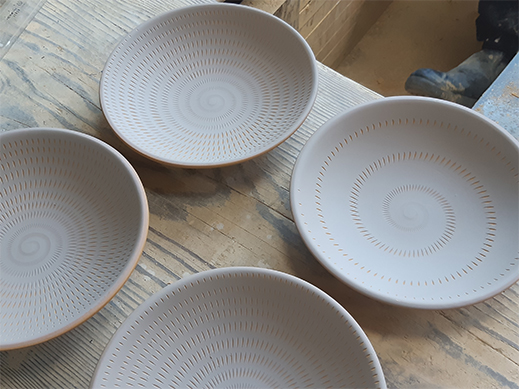 |
|
Freshly made chatter marks on an as-yet-unfired piece of Koishiwara ware, demonstrated by Shin'ichi Yanase, another potter and head of the local kiln association. Photo by Alice Gordenker |
Other regional potteries, notably Bizen ware and Hagi ware, have received the benefit of several generations of assistance from the Living National Treasure program, but Fukushima is the first person asked to look after the future of Koishiwara ware. And by unhappy coincidence, Koishiwara badly needed a protector at the time of Fukushima's appointment. In early July 2017, just days before Fukushima's selection was announced, heavy rains caused flooding and massive landslides in northern Kyushu. More than half of the 50 kilns in Koishiwara suffered significant damage. Work throughout the community came to a halt as neighbors helped neighbors, and volunteers poured in from around the country to help dig the village out. Today, all the kilns are back in operation.
Fukushima was born in 1959 into a long line of potters in Koishiwara and chose, after completing university, to carry on the family tradition. He initially planned to begin with an apprenticeship elsewhere in Japan, but after visiting other pottery centers decided he could best learn what he needed from his own father and grandfather. "I was determined to do something new," he recalled in a recent interview, "but I wanted to do that at home. My intention was to use our local materials in entirely new ways, and to make something that had never been made before."
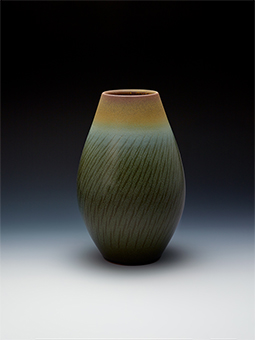 |
|
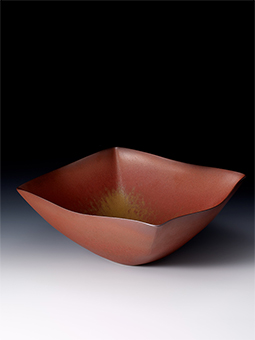 |
|
|
|
|
Through repeated experimentation, Fukushima drew this rich green out of iron glaze. The pattern around the body references tobi kanna but was applied using stenciling.
|
|
An example of Fukushima's kaku-yu series. The distinctive red is due in part to Koishiwara clay added to the glaze. |
Fukushima has achieved this goal, many times over, including developing a number of highly distinctive glazes. "It takes five to ten years, and constant trial and error, to arrive at something that works," he explained. One of his early successes was coaxing a surprising green color out of iron glaze. He artfully combined this with his own interpretation of Koishiwara's characteristic chatter marks, throwing large shallow bowls with broad rims on which he etched a finely detailed pattern of minute marks. Later, he developed a rich red glaze he named kaku-yu and a beautiful chocolate brown-black glaze called ame-yu, meaning "candy glaze."
Perhaps Fukushima's finest achievement can be seen in his work with celadon glaze. When celadon is applied to earthenware, fine cracks known as "crazing" generally form in the glaze. This occurs because the glaze contracts more than the body as it cools. "People just accept this, but I didn't think it had to be," Fukushima told me. Through careful control of his formulas and firing process, Fukushima perfected a smooth and crack-free surface accompanied by a beautiful soft blue tone in the glaze. He named this triumph Nakano geppaku-ji, or "Nakano Moon White" celadon. (Nakano is the place in Koishiwara where the local clay is dug.) At the rim and along the ridges he crafts for contrast, Fukushima carefully removes some of the glaze to allow the natural color of the clay to show, and the dark lines work beautifully to pull the composition together.
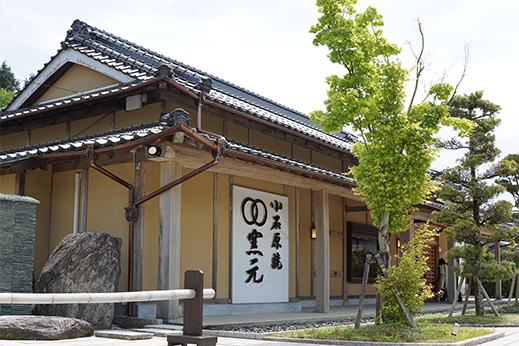 |
|
Zenzo Fukushima's Chigaiwa kiln in Koishiwara, Toho Village, Fukuoka Prefecture. Photo by Masaya Kuroda |
In preparing his clay, Fukushima is meticulous, sieving it repeatedly to get a very fine medium that he is able to turn on the wheel into sharply defined shapes and flowing lines that are distinctly modern. He is also clearly a perfectionist: in his workshop, he showed me a stunning celadon piece that he felt forced to reject due to a tiny pinhole in the glaze. Only flawless works make it into his exhibitions and showroom.
Fukushima's successes with local materials have encouraged younger potters in the area, spurring them on in their own efforts to innovate. "It's difficult to express individuality if you limit yourself to the traditional Koishiwara motifs, but all of our kilns are now finding ways to distinguish themselves," he said. "Koishiwara today is one of the most vibrant ceramic production areas in all of Japan, with more kilns than ever before and offering a great deal of variety." Fukushima takes his role as "preserver" seriously, offering guidance and, last year, joining nine younger colleagues to present a special exhibition of contemporary Koishiwara ware. "With recognition comes responsibilities," he said. "When you are a Living National Treasure, you have to be a leader."
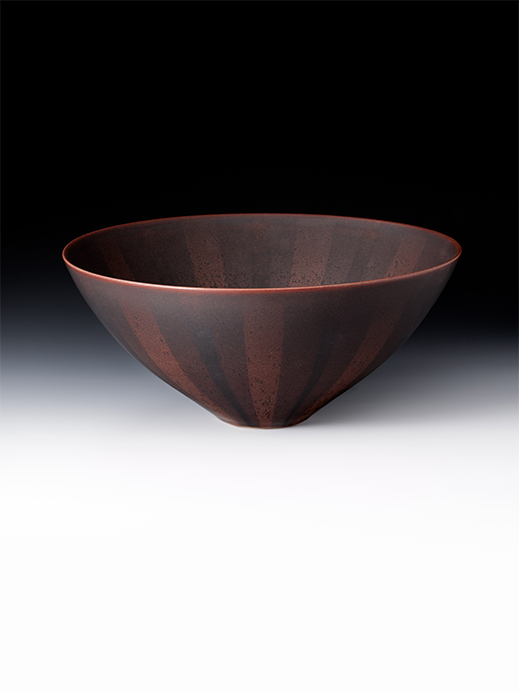 |
|
A bowl with Fukushima's distinctive ame-yu glaze. |
Images courtesy of Zenzo Fukushima unless otherwise noted. |
 |
| Zenzo Fukushima's Chigaiwa Kiln |
978-2 Koishiwara, Toho-mura, Asakura-gun, Fukuoka Prefecture
Phone: 0946-74-2056
Hours: The showroom is open to visitors without an appointment during the local pottery festivals (May and October). At all other times, visitors are requested to make advance arrangements by telephone. Examples of Fukushima's works are also on display at the Koishiwara Ceramics Museum, along with a very good selection of works by other contemporary Koishiwara potters as well as historical materials.
|
| Koishiwara Ceramics Museum |
730-9 Koishiwara, Toho-mura, Asakura-gun, Fukuoka Prefecture
Phone: 0946-74-2266
Hours: 10 a.m. to 5 p.m. Closed on Mondays except when Monday is a national holiday (in which case the museum is closed the following day), and 27 December - 1 January.
Access: The closest airports to Koishiwara, which is part of Toho Village, are Kitakyushu and Fukuoka. Rental cars are available at both airports. Express buses from Fukuoka Airport and the Hakata and Tenjin bus terminals in downtown Fukuoka will get you as far as the Haki Bus Center in Asakura, where you can change to a local bus to Toho. During the biannual Koishiwara Folk Pottery festivals (May and October), the Nishitetsu bus company operates special direct service from Fukuoka.
|
| Upcoming Zenzo Fukushima Solo Exhibitions in 2020: |
Tokyo: 18-24 March, Seibu Ikebukuro Department Store;
Yokohama: 14-20 April, Sogo Department Store;
Chiba: 19-25 May, Sogo Department Store; Osaka: 5-7 June, Takanawa-kai |
|
 |
 |
Alice Gordenker
Alice Gordenker is a writer and translator based in Tokyo, where she has lived for more than 20 years. For over a decade, she penned the "So, What the Heck Is That?" column for The Japan Times, providing in-depth reports on everything from industrial safety to traditional talismans. She translates and consults for museums, and has a special interest in making Japanese museums more accessible for visitors from other countries. |
|
 |
|